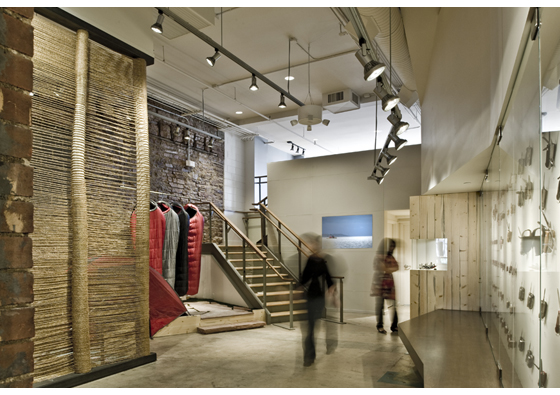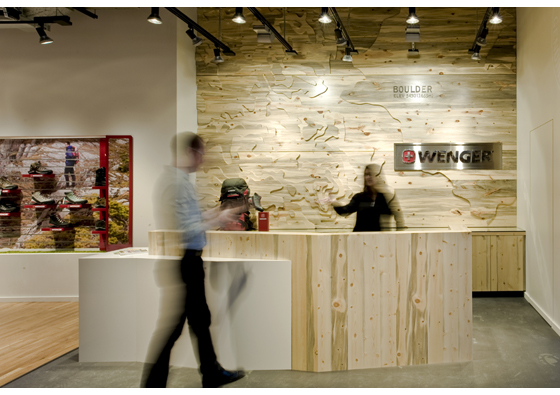The Swiss Army knife is seen everywhere. It’s a brand widely known for its quality, precision, and durability. So when Wenger, the maker of iconic knives and watches, set out to launch a flagship store that would also introduce a new line of footwear, they wanted to leverage any positive brand legacy they could transfer to the new shoe line.
It was a rare opportunity to take a brand with such a rich legacy into a new market sector. We started with the knife as the pivot point for everything in the store. Using that as a springboard, we tailored the store design to reflect Wenger’s dual brand concepts of authenticity and multi-functionality.
We did a lot of things to break out of the mold. The watches, usually locked in a display case, are displayed where people can examine them closely. It was important that all of the characteristics you associate with Swiss Army brands – things like precision engineering and durability – got conveyed in a way that people could touch and feel it.
That aspect of the Wenger/Swiss Army store was highlighted when the project was recognized with a Gensler Design Excellence Award. Carl Muhlstein, a member of the panel that judged the projects, told us the customers’ ability to interact with the merchandise was one of the store’s best attributes. Muhlstein, a senior director at Cushman & Wakefield, noted that bricks-and-mortar shops are in stiff competition with e-commerce. So retail stores need to set themselves apart by engaging customers with good design and relevant programming.
To get it right, Gensler worked closely with Wenger licensee Established Brands International. They chose to launch the concept in Boulder, Colorado, because it’s a mecca for the outdoor lifestyle. A lot of the architectural moves are about revealing the rugged characteristics of the building. Historic local materials – like the worn wooden floors and stone walls – give the interior an authentic look and speak to the 116-year history of the Wenger brand.
Almost everybody has a memory associated with their first Swiss Army Knife, and we looked for a compelling way to engage with customers to capture those stories. We took the idea of the multifunctional knife and applied it in our design. To do that, we put the knives toward the rear of the store and created a multifunctional space. It’s kind of a community hub – a gathering place where small groups can meet for lectures, training or video demonstrations. That’s also where we placed a display case housing “The World’s Largest Knife.”

The focal point is a woven wall sculpture that doubles as a collection point for photos and handwritten stories placed there by customers. It is filling up fast. A local artist made the sculpture using logs of beetle-kill pine – a material well known to local hikers and campers, because pine beetles are ravaging the Colorado forests. Using the wood in store finishes and shelving – even in the 3-D map on the wall behind the register – reminds store visitors of the environment’s fragility. All of these gestures give the community a strong connection to the store and reinforce the Wenger brand.

 |
Harry Spetnagel is an Associate Design Director in Gensler’s Denver, Colorado office. He has worked more than two decades in project management, communications, and sign/graphic design. Contact him at harry_spetnagel@gensler.com. |
